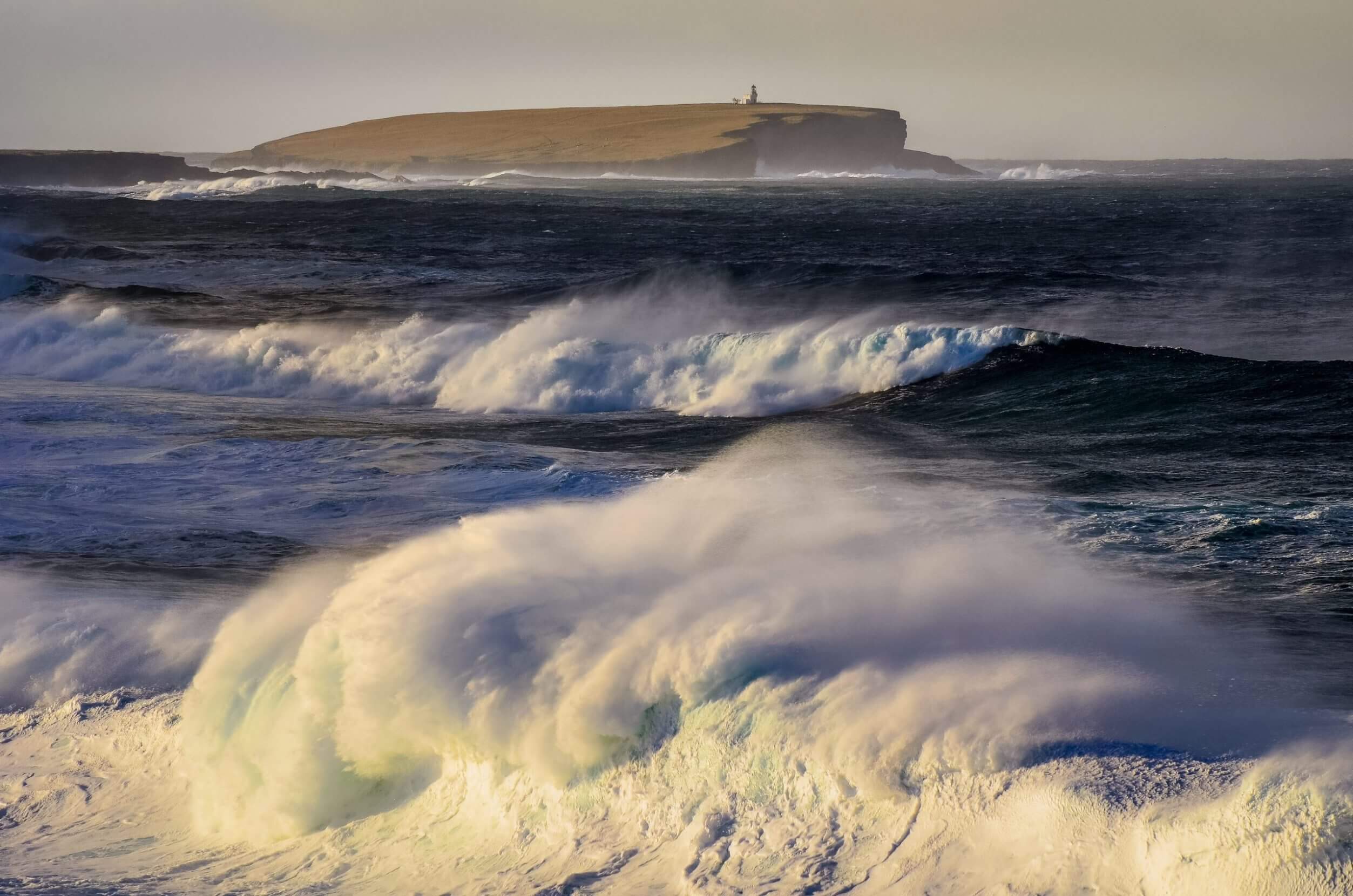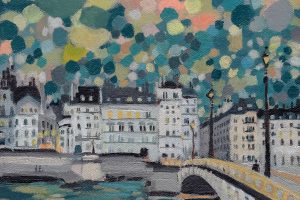Support Hidden Compass
Our articles are crafted by humans (not generative AI). Support Team Human with a contribution!
There was only one approach by land, and it was temporary. At low tide, the sea had recoiled to reveal a narrow cement walkway that zigzagged 800 feet across a dark stone reef draped in kelp and mottled with shimmering tide pools. The walkway rose several feet above the jagged rock, looking exposed and haphazard, a precarious tether to the small island that stretched across the horizon at the other end.

Looking across the sea to the formidable Brough of Birsay in the Orkney Islands of Scottland. The Brough of Birsay was once the stronghold of the Raven-Feeder. PHOTO: GERRY CANNON.
The Brough (rhymes with “rock”) of Birsay is a circular, treeless plateau, the northwestern tip of Scotland’s Orkney archipelago, jutting dauntlessly into the North Atlantic like the last stepping stone of the continent. Now uninhabited, the Brough was home to humans as far back as the Neolithic. The last occupants were Vikings, who arrived in the 9th century and remained for nearly 400 years. Life on the Brough could be brutal, a perpetual battle against the elements that were now whittling away the final remnants of human habitation. I could see fragments of village ruins from the walkway.
On the day of my visit, winds gusted to 50 mph as thick furrows of clouds menaced on the horizon. It was fitting, I thought, given the demeanor of the island’s most notorious resident, Thorfinn Sigurdsson, the Viking earl of Orkney. He was described in the Viking history of Orkney, The Orkneyinga Saga, as “…the tallest and strongest of men, ugly, black-haired, sharp-featured, and big-nosed, and with somewhat scowling brows.”
Thorfinn was among the most feared of all Viking raiders. He once controlled the territory from Shetland to Northern Ireland. From the age of 14, he joined in raids throughout the British Isles. As earl, he terrorized Northern Scotland, slaying men, taking women and children captive, and burning villages. He repeated his attacks yearly to remind the vanquished of the destruction he could wield. Even Vikings — even Thorfinn’s own kinfolk — who dared to encroach on his territory fell victim to his avarice. The Orkneyinga Saga describes him in battle with “a gold-plated helmet on his head, a sword at his belt, and a spear in his hand, [as] he cut and thrust with both hands.” An equal threat on sea and land, he burned and slashed his way through battles, decimating entire armies in the process. Such carnage did he leave in his wake, he earned the name Raven-Feeder — for the ravens who fed on the corpses of his fallen enemies. Arnor Jarlaskáld, the Earls’ Poet, often accompanied Thorfinn on his raids, leaving lyrical records of the slaughter:
Ships grappled
together; gore, as foes fell,
bathed stiff iron, black
with Scots’ blood;
singing the bows spilt
blood, steel bit; bright
though the quick points quaked,
no quenching Thorfinn.
~~
I picked my way carefully towards the island. Large sections of the walkway were covered with a slimy green moss made more hazardous by bursts of wind and intermittent rain. One careless step could send me sliding down to the rocks below. From the end of the walkway, I climbed a steep trail along the Brough’s southern cliffs up to the grassy surface above. The sea had gnawed at this scarp for centuries. Though attempts had been made to bolster the eroding face with riprap and concrete, portions of the plateau above me had already tumbled into oblivion along with pieces of the village. Despite the reinforcement, the cliff’s demise was inevitable.
Such carnage did he leave in his wake, he earned the name Raven-Feeder — for the ravens who fed on the corpses of his fallen enemies.
The island’s role as a stronghold was reflected in its Old Norse name. “Brough” came from borg, meaning fort or place easily defended. “Birsay,” came from byrgisey for island fort. Towering sandstone cliffs protected most of the Brough from sea attack. The low slope I’d scaled from the walkway was the only vulnerable flank, but it was defensible from the village. This natural fortress served as a promontory from which the early Vikings launched attacks against passing trade ships. The island was exposed to the open sea, but it also loomed over it.
The trail faded away at the top of the cliff near the edge of the ruins. The village, at first glance, resembled a floor plan in relief. Interconnecting walls of dry-set stone, each several feet high, marked the outlines of former buildings that betrayed little evidence of Thorfinn’s savagery. The foundations were inanimate, mute, with only the roar of wind and the thundering surf to breathe life into an otherwise dormant scene. Stones stretched out like the unearthed skeleton of some massive creature whose bones lay undisturbed in the place where it had fallen. It was only by imagining the walls of each longhouse at their full height, crowned with thatching, smoke from cooking fires threading across the sky, and longboats rocking offshore, that I could picture the citadel that had since become a ghost town.
~~
A Viking church straddled the center of the village and was encircled by a walled cemetery with a dozen or so graves. Each grave was covered by a rectangular ledger stone meant to protect the dead from marauding animals. The concept of a Viking church baffled me. Vikings fought boldly, hoping for a place with the gods in Valhalla. Why should they forsake them? I had difficulty picturing those same warriors in church. Yet, it was the fearsome Thorfinn who successfully imposed Christianity on Orkney.
The son of a Scottish mother and a Norse father, Thorfinn had been raised as a Christian. As a middle-aged man, after decades of war and bloodshed — years of feeding the ravens — Thorfinn suffered a crisis of conscience. He ceased his bloody raids, moved his family to the Brough of Birsay, and devoted himself to governing his people. That attempt at atonement must have proved lacking because he later embarked on a two-year-long pilgrimage. After paying homage to sovereigns in Scandinavia and Saxony, he continued to Rome for an audience with the new pope. Thorfinn realized absolution would be hard won after so many heinous acts. Even Vikings who embraced Christianity had difficulty escaping their pagan reputations. So Thorfinn offered to build a cathedral in Orkney and requested a bishop to oversee the spiritual needs of his people.
The Brough’s church was its largest and most well-preserved ruin, having served as both a chapel and monastery. The remaining walls stood five feet high in places and included an alcove and altar. Stone benches lined the walls of the two large rooms. Seated on one of the benches, I was partially sheltered from the raging wind. It was cold but quiet. Serene. Perhaps it was the serenity that Thorfinn had craved — peaceful respite from the blood and gore of the battlefield. From my position on the bench, I could see the mainland part of Birsay and the remains of the 16th century Earl’s Palace in the distance.
Though Vikings ruled Orkney for hundreds of years, it fell under Scottish control in the 15th century. The territory that Thorfinn had spent a lifetime procuring — a realm built on all those battlefields of corpses — passed into the hands of Robert Stewart, the first Scottish earl. Stewart built an opulent palace for himself within eyeshot of the Brough’s rustic village. He and his son Patrick, who succeeded him, tormented the people of Orkney in a despotic reign that ended in violent revolt and Patrick’s execution. Thorfinn, by that time, had been forgotten and his vast realm, dismantled.
~~
A succession of breakers had begun rolling in towards shore like a slow-moving army, attacking the ragged stone reef in spumes that reached ever closer to the concrete walkway. The North Atlantic would soon reclaim the island. There was something primal about a tidal island and synchronizing one’s movements with the earth’s natural rhythms. It was a reminder of humankind’s transience in a world inconceivably vast and enduring.
Thorfinn, witnessing this same cycle of tides on the Brough, may have realized that time and the elements were his real enemies, forces that were immune to sword and spear. Whether he was sincerely repentant or simply hedging his bets, the transition from Raven-Feeder to pious governor may have been a bid for a more durable legacy. The impermanence of a conquered land or a stone edifice would have been evident to him. The first would be surrendered; the other, lost to the sea.

The walkway to the Brough of Birsay in the Orkneys only emerges at low tide. PHOTO: KEITH SKINNER.
As I started across the walkway back to the mainland, I turned for one last, intimate glimpse of the Brough. The sky was less heavy, but still moody. The wind continued at full force. Even in better weather, the island would have exuded the portentous, charismatic quality of something possessed.
Maybe Thorfinn’s crusade for immortality had paid off after all.
Keith Skinner
Keith Skinner is an award-winning writer who is endlessly curious about the why of things.



